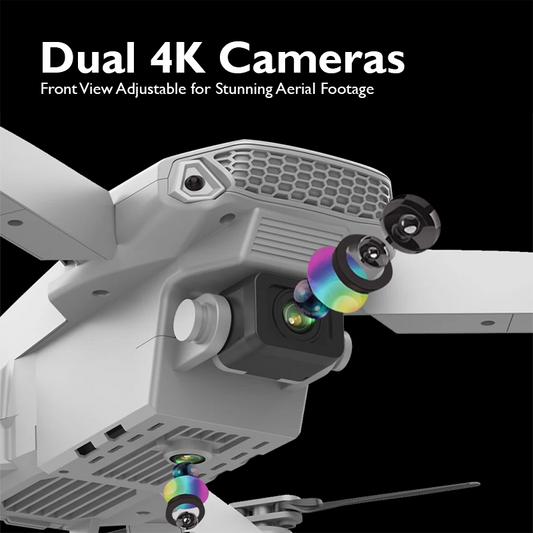A Guide to Drone Surveillance Technology

In the rapidly evolving landscape of technology, drone surveillance has emerged as a game-changer in various industries, from security and agriculture to filmmaking and environmental monitoring. This comprehensive guide will navigate you through the intricate world of drone surveillance technology, shedding light on its applications, benefits, and considerations.
Understanding Drone Surveillance Technology

Drone surveillance technology involves the use of unmanned aerial vehicles (UAVs) equipped with advanced cameras and sensors to gather data and monitor areas from the sky. These drones have become increasingly popular due to their versatility and efficiency, providing unique perspectives that were once impossible to achieve.
Applications of Drone Surveillance
1.Security and Law Enforcement

One of the primary applications of drone surveillance is in the realm of security and law enforcement. Drones equipped with high-resolution cameras and thermal imaging sensors can be deployed to monitor large areas, enhance situational awareness, and respond rapidly to security threats. This technology is particularly beneficial in border control, public event management, and crime prevention.
2.Agriculture and Crop Monitoring

Farmers are leveraging drone surveillance technology to revolutionise traditional agricultural practices. Drones equipped with multispectral cameras can capture detailed images of crops, enabling farmers to assess plant health, identify pests or diseases, and optimise irrigation. This not only increases crop yields but also promotes sustainable farming practices.
3.Infrastructure Inspection

Drones are proving to be invaluable in inspecting critical infrastructure such as bridges, power lines, and pipelines. They can navigate challenging terrains and capture high-resolution images, allowing inspectors to identify potential issues without the need for expensive and time-consuming manual inspections. This enhances overall safety and reduces maintenance costs.
4.Environmental Monitoring

For environmentalists and researchers, drone surveillance offers an unprecedented ability to monitor ecosystems and wildlife. Drones can access remote and hard-to-reach areas, collecting data on deforestation, pollution levels, and animal behaviour. This information is crucial for conservation efforts and environmental impact assessments.
Benefits of Drone Surveillance Technology

1.Cost-Effective
Compared to traditional surveillance methods, drone technology proves to be more cost-effective. Drones can cover large areas in a relatively short amount of time, reducing the need for extensive manpower and resources. This is particularly advantageous in industries such as agriculture and infrastructure inspection.
2.Efficiency and Speed
Drones provide a swift and efficient means of data collection. Whether it's monitoring a large agricultural field or responding to a security threat, drones can quickly reach the desired location and relay real-time information. This speed is crucial in situations where rapid decision-making is paramount.
3.Enhanced Safety
In sectors like infrastructure inspection and public safety, drones contribute to enhanced safety measures. They can access hazardous or difficult-to-reach areas without endangering human lives. This not only minimises the risk to personnel but also allows for more thorough and precise inspections.
Considerations for Drone Surveillance

1.Regulatory Compliance
As drone technology advances, regulatory bodies are implementing rules to ensure safe and responsible use. It's crucial for businesses and individuals to stay informed about local and international regulations governing drone surveillance. Failure to comply with these regulations can result in legal consequences.
2.Privacy Concerns
The use of drone surveillance raises legitimate privacy concerns. As these devices can capture images and videos from vantage points not accessible by traditional methods, it's important to establish clear guidelines on what can and cannot be monitored. Open communication and transparency are essential in addressing and alleviating privacy concerns.
3.Security Risks
While drones enhance security measures, they also pose potential security risks. Unauthorised access to drone communication systems or the hijacking of drones for malicious purposes are concerns that must be addressed. Implementing robust cybersecurity measures is imperative to mitigate these risks.
4.Environmental Impact
Drone technology, like any other technological advancement, has an environmental footprint. The production and disposal of drones, as well as the energy required for their operation, should be considered. Balancing the benefits of drone surveillance with its environmental impact is essential for sustainable implementation.
Drone surveillance technology is reshaping industries and revolutionising the way we approach various tasks. From enhancing security to optimising agricultural practices, the applications are diverse and promising. However, it's crucial to navigate this technology with a balanced perspective, considering the associated benefits, considerations, and potential challenges. By staying informed about regulations, addressing privacy concerns, and implementing robust security measures, we can unlock the full potential of drone surveillance technology for a safer, more efficient, and sustainable future.
Explore a variety of drones at our online drone store.
Happy Flying!











